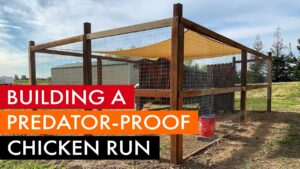Last updated on August 5, 2025
You’ve read the warnings and you know the threats. Now, it’s time to roll up your sleeves. Securing your chicken coop doesn’t have to be expensive or require a professional contractor. With a few basic tools and a weekend afternoon, you can dramatically upgrade your flock’s security.
This guide provides step-by-step instructions for five high-impact DIY projects that will stop predators in their tracks. We’ll walk you through each project with clear instructions, materials lists, and pro-tips from our own experience to ensure you get it right the first time. These projects are the practical application of the strategies discussed in our Ultimate Guide to Chicken Predator Protection. If you’re unsure why these steps are so critical, we recommend reading that guide first.
The 5 High-Impact DIY Projects to Predator-Proof Your Chicken Coop
Project #1: Installing a Buried “Predator Apron”
Problem it Solves: Stops digging predators like foxes, coyotes, and dogs from tunneling into your run or coop.
Materials & Tools:
- 1/2-inch hardware cloth (at least 24 inches wide)
- Heavy-duty staples or zip ties
- Shovel
- Tape measure
- Thick work gloves
Step-by-Step Instructions:
- Dig a trench 12 inches wide and 6-8 inches deep around the entire perimeter of your run.
- Bend the hardware cloth into an “L” shape, with 12 inches going up vertically and 12 inches extending horizontally.
- Attach the vertical part of the “L” to the bottom 12 inches of your run’s fence using staples or zip ties.
- Lay the horizontal part of the “L” flat in the trench, extending away from the coop. This creates a barrier that digging animals hit before they can tunnel under the main fence.
- Backfill the trench with the removed soil, burying the horizontal section of the hardware cloth.
Pro-Tip: Wear thick leather gloves when handling hardware cloth. The cut edges are incredibly sharp and can cause nasty cuts. As Kathy, “The Chicken Chick” from Rethink Rural, advises for deterring digging predators, “To protect your birds from predators that dig, you can bury fence posts and hardware cloth six to twelve inches below the surface.” Source: Rethink Rural This is your best defense against the digging tactics used by foxes and coyotes.
Project #2: Upgrading to a Two-Step Latch System
Problem it Solves: Outsmarts intelligent, dexterous predators like raccoons who can manipulate simple latches.
Materials & Tools:
- A sturdy barrel bolt
- A carabiner clip (snap hook)
- Drill
- Screwdriver
- Pencil
Step-by-Step Instructions:
- Install the barrel bolt on your coop door according to its instructions, ensuring it slides smoothly.
- With the bolt slid closed, drill a small hole (just large enough for the carabiner clip) through the end of the bolt’s sliding pin.
- Once the bolt is slid closed, clip the carabiner through the hole you drilled.
- To open, this system now requires two distinct motions: unclipping the carabiner and then sliding the bolt.
Pro-Tip: Install two of these systems on each door—one high and one low—to completely frustrate even the most persistent raccoon. As TikTok creator ChickenSchmidtFarms warns, “You wanna make sure that you use a two step locking system. like a hasp with an auto locking carabiner. This requires some extra steps and some extra work on your part, but it will help keep those raccoons out.” Source: TikTok This two-step system is essential for defeating raccoons, as we detail in our complete raccoon-proofing guide.
Project #3: Securing Vents and Windows with Hardware Cloth
Problem it Solves: Closes off the most common hidden entry points for small predators like weasels, snakes, and even determined raccoons.
Materials & Tools:
- 1/2-inch or 1/4-inch hardware cloth
- Tin snips
- Heavy-duty staple gun
- Screws and washers
- Drill
Step-by-Step Instructions:
- Measure your window or vent opening precisely.
- Using tin snips, cut a piece of hardware cloth that is 2 inches larger than the opening on all sides. This overlap provides a secure attachment surface.
- Staple the cloth securely over the opening, ensuring it is taut and flush against the coop frame.
- For maximum security, add a screw and washer in each corner and every 6-8 inches along the perimeter.
Pro-Tip: Don’t rely on staples alone for raccoon-proofing. Screws with washers are essential, as a raccoon can pry staples loose over time. Kathy from Rethink Rural emphasizes, “Cover any openings with hardware cloth, which should be secured to the coop with screws and washers, rather than staples. This includes windows; screens will not deter predators.” Source: Rethink Rural
Project #4: Building a Simple A-Frame “Hawk Hideout”
Problem it Solves: Provides essential, immediate cover for free-range chickens against aerial predators like hawks and owls.
Materials & Tools:
- Two sheets of scrap plywood (or sturdy pallets)
- Hinges or screws (if using plywood)
- Drill
Step-by-Step Instructions:
- Create a simple A-frame by leaning two pieces of plywood against each other, forming a triangular tunnel.
- Secure them at the top with hinges for easy portability, or by driving several long screws through the peak if it’s a permanent structure.
- Place several of these “hideouts” around your yard, especially in open areas where chickens forage.
Pro-Tip: Place the hideout near a dust bathing area. Your chickens will love the feeling of security while they bathe, and it provides crucial cover from aerial threats like hawks and owls, as discussed in our guide on Protecting Chickens from Hawks and Owls. As Smart Chicken Door suggests, “One way to help your chickens stay safe is to provide them with hiding places… Whether it’s bushes, shrubs, or any covered area, make sure they have a place to move out of sight if a hawk is circling overhead.” Source: Smart Chicken Door
Project #5: Creating a “Scare Tape” Defense Grid
Problem it Solves: Deters hawks with a cheap, dynamic, and effective visual barrier that disorients them.
Materials & Tools:
- Roll of reflective scare tape (flash tape)
- Several tall garden stakes or poles
Step-by-Step Instructions:
- Place stakes around the perimeter of your chickens’ main foraging area, about 10-15 feet apart, ensuring they are tall enough to suspend the tape above chicken height.
- String the scare tape between the stakes in a crisscross pattern, about 4-6 feet off the ground.
- Ensure the tape is strung loosely enough that it can twist and flutter in the wind, maximizing its reflective flashes.
Pro-Tip: Change the pattern of the tape every few weeks to prevent birds from becoming accustomed to it. This constant novelty maintains its effectiveness as a hawk deterrent. Bird B Gone LLC highlights that “Holographic Flash Tape is the simplest and most cost-effective bird control method you can buy. It is designed from commercial-grade Mylar. The tape is highly reflective and shiny and will cause a visual disturbance that scares the birds away.” Source: Bird B Gone LLC
Conclusion: A Safer Coop, One Project at a Time
You don’t need to tackle all these projects at once. Even completing one or two of these DIY upgrades this weekend will make a significant difference in your flock’s safety. By taking these practical, hands-on steps, you are building more than just a coop; you are building a fortress. Your peace of mind and your chickens’ safety are well worth the effort.
Quick FAQs on DIY Projects to Predator-Proof Your Chicken Coop
What is the cheapest way to predator-proof a coop?
The most cost-effective, high-impact upgrades are securing all vents and windows with hardware cloth (Project #3) and upgrading to a two-step latch system (Project #2). These two projects solve the most common entry points for the most common predators.
How do I predator-proof my coop on a budget?
Focus on using hardware cloth over chicken wire, creating your own DIY shelters from scrap materials (Project #4), and using inexpensive scare tape (Project #5). Prioritize securing entry points over large-scale fencing initially.
What is the single most important predator-proofing task?
Meticulously covering every single small opening with hardware cloth. Predators like weasels and raccoons will exploit any gap they can find, and this single task eliminates that threat.


